Brimfield
Antiques Fair Report, May, 2014
Day 1 (Tuesday, May 13)
A new Brimfield year began this
morning at "day break" (5 am) when many of the free fields open. The crack
meteorologists in the area were forecasting cloudy skies and drizzle developing
through the day. But like so often, these harbingers of doom were wrong,
and the weather was magnificent--right through Thursday. Often I think
that if the government really was serious about reducing costs, they would
eliminate the U.S. Weather Bureau and the many satellite parasites that depend
upon it. Actually I reached Brimfield about 1/2 hour later that usual
today, figuring that it would be a long day, and having reached the
three-quarter century mark, I better start taking better care of myself.
The first field visited (as usual)
was Quaker Acres, and from the second dealer I walked past I bought a nice small
alidade with level vial, sighting vanes, and marked only "U.S." on the bottom.
Clearly a military field item, it was in great condition at a reasonable price.
Maybe it would be signal the start of a good day. That first omen was
followed by a visit to one of the most reliable dealers in the field who had a
number of nice things to consider. The first was a cased boat caulking kit
that contained two fids, a half-dozen caulking irons of good variety, and two
nice caulking mallets. The mallets were of two sizes, and the smaller one
was a dandy example clearly marked by C. Drew & Co--who made fine caulking
mallets. A few other things caught my eye, including a fine example of
Starrett's No. 164 adjustable T-Square, and No. 62 four-fold rule, and a good
example of the Stephens No. 36 combo rule & level. Getting on with the
rule gig I also bought a very clean Stanley 34 1/4 VR bench rule, and an
uncommon H. Davidson boxwood tailor's rule. My final purchase from this
dealer was a cast iron paper weight in the form of a miniature decoy. Cast
into the bottom of the decoy is the name of the North Bros. Foundry in
Philadelphia. I had not seen one of these before. It predates North
Bros' entry into the screw driver business, and fits well with a pair of small
ice tongs that I own that also were produced by North Bros in the 1880s.
Settling up with the dealer, I stashed my purchases with him, and went shopping
for more.
The next stop resulted in no buys,
but I nearly pulled the trigger on a craftsman-made plumb bob that was
mercury-filled. Of course the Starrett & B & S mercury filled bobs are
fairly common, but this was the first home-made example that I've seen.
The condition was just not good enough, so I went on my way moving out of the
field and headed south along Rte 20. Not far down the road a guy had a
heap of machinist chests with tools, and I managed to glean a fairly nice B&S
set of square calipers, and a pair of Starrett V-blocks. The V-blocks were
interesting in that they were the No. 271 set of two, with a spindle to keep
them in line. The yokes (clamps) in this number are more rounded that
those usually seen with other V-blocks, and are distinctive. So they went
into the bag as well. Continuing though the Mahogany Ridge field I picked
up a very clean Pexto draw knife, a good Yankee screw driver, & a "K & B Co"
(New Haven) tack hammer that has a good look to at, and apparently uncommon.
A prize on this segment of the trip was a H.D. Smith perfect handle draw knife
in great condition and at a great price.
I dropped the accumulated swag off,
and then went back to get my stash from Quaker Acres. Getting there I ran
into my dealer's partner, and managed to part him from a few tools that he had,
including a Stanley No.7C jointer plane, a fine Stanley No.200 honing guide
(complete) and a good whetstone, in covered case. Another visit to the
truck was required to offload the bag of tools. What followed was a
leisurely walk to to the west along Route 20, diverting to various fields, and
now and finding something decent. This amble produced a very good Stanley
No. 8C jointer plane, a crispy Starrett No. 85B extension dividers, and an
unmarked (not Stanley) mahogany panel gage. The best find was a Fray
Spofford Brace in the 12 inch sweep, along with 3 large bore auger bits.
At the western end of the Brimfield
show are two fields across Rte 20 from each other and are known as Dealers
Choice and Brimfield North. Dealer's choice opens for business at 11 am
($5 admission), and Brimfield North opens 2 hours later, at 1pm also with a $5
admission. Just before the first opening, I did find an interesting level.
It is a wooden level, low and squat, with old red paint and a top plate of wood
that is about 1/8" thick. This top plate is bounded at each end in bread
board fashion with wood having strange inlays. One inlay appears to have a
fish form, the other a fairly sinuous figure. At any rate this was a
strange and old looking level. So despite the hefty price, I bought it.
Dealer's Choice is a field that often
has dealers flogging scrimshaw and other nautical stuff, so I moved fairly
carefully around--but with little luck. I did buy a case of a dozen NW
Coast carved small pins (carved out of ivory, bone, and fossil ivory). But
my only other purchase was group bench planes that included Stanley 4, 5 & 6
bench planes, a Millers Falls jack plane, the body and auxiliary fence from an
early type No. 46, and good example of the scarce Sargent No. 2204 block plane.
This group of planes had enough heft to require a long walk back to the truck,
and then an equally long hike back to the Brimfield North field before it opened
at 1 pm. I made it with a few minutes to spare, and joined the crush
(crowds were very large all day) getting into the field. My purchases here
were sparse to be sure. I bought only a smaller, slim whale bone fid, and
a framed ink sketch. The latter, however, was my prize of the day.
It was a sketch (in original period frame) of a topsail schooner named the,
"Peace Mosher." from my home town of Westport, Mass. and dated 1816. Even
though the heavy ink on the hull had oxidized the paper badly, it has a great
look. At home I located in our town's early Vital Statistics that Peace
Mosher (nee Peace Gifford) had married Brice Mosher (both Quakers) in 1799, and
had had 5 children by 1812. The vessel in this drawing was surely named
after her. There is a lot of interesting research to be done. This
buy capped a good day at Brimfield! A couple of pictures follow:
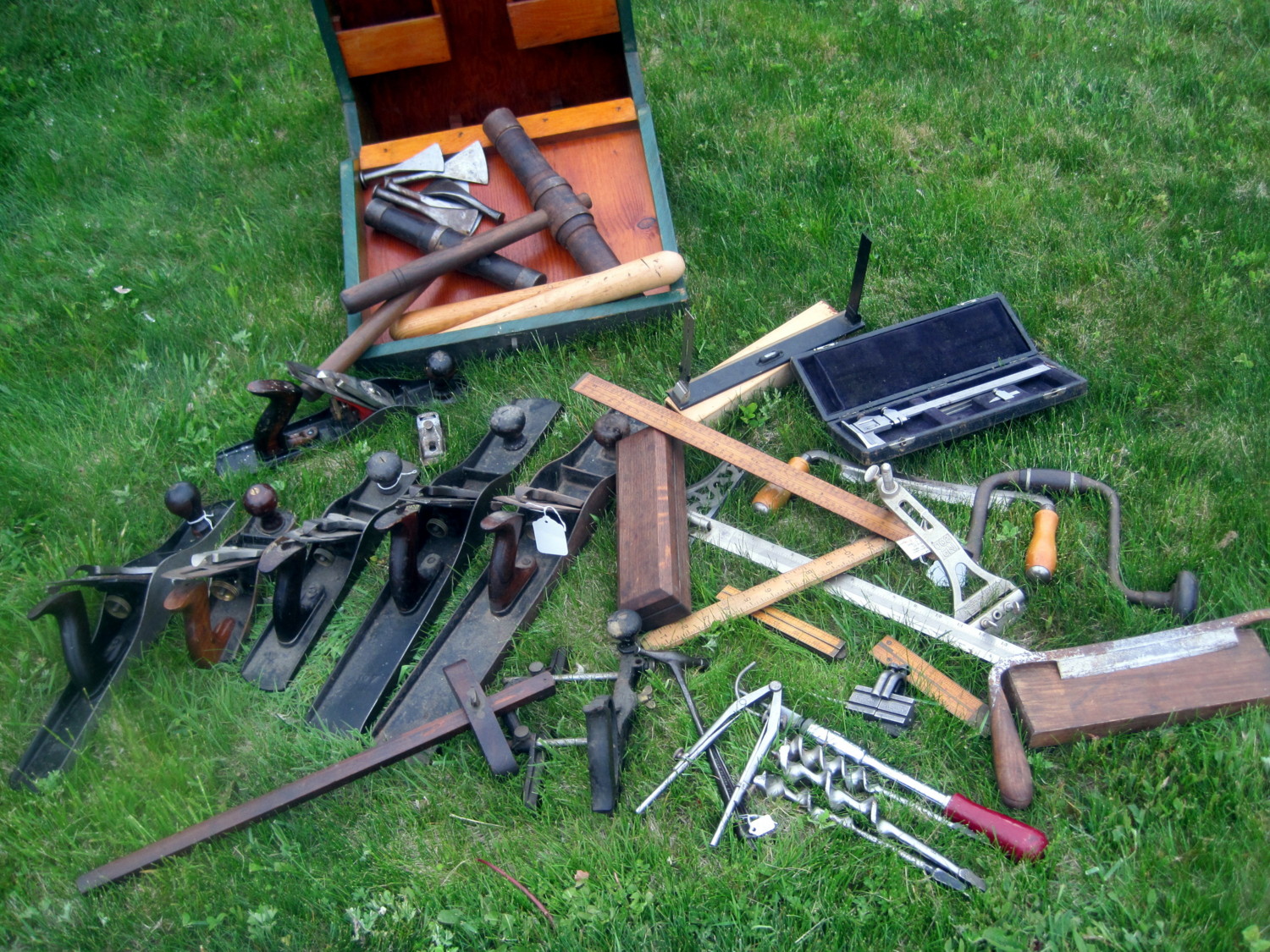
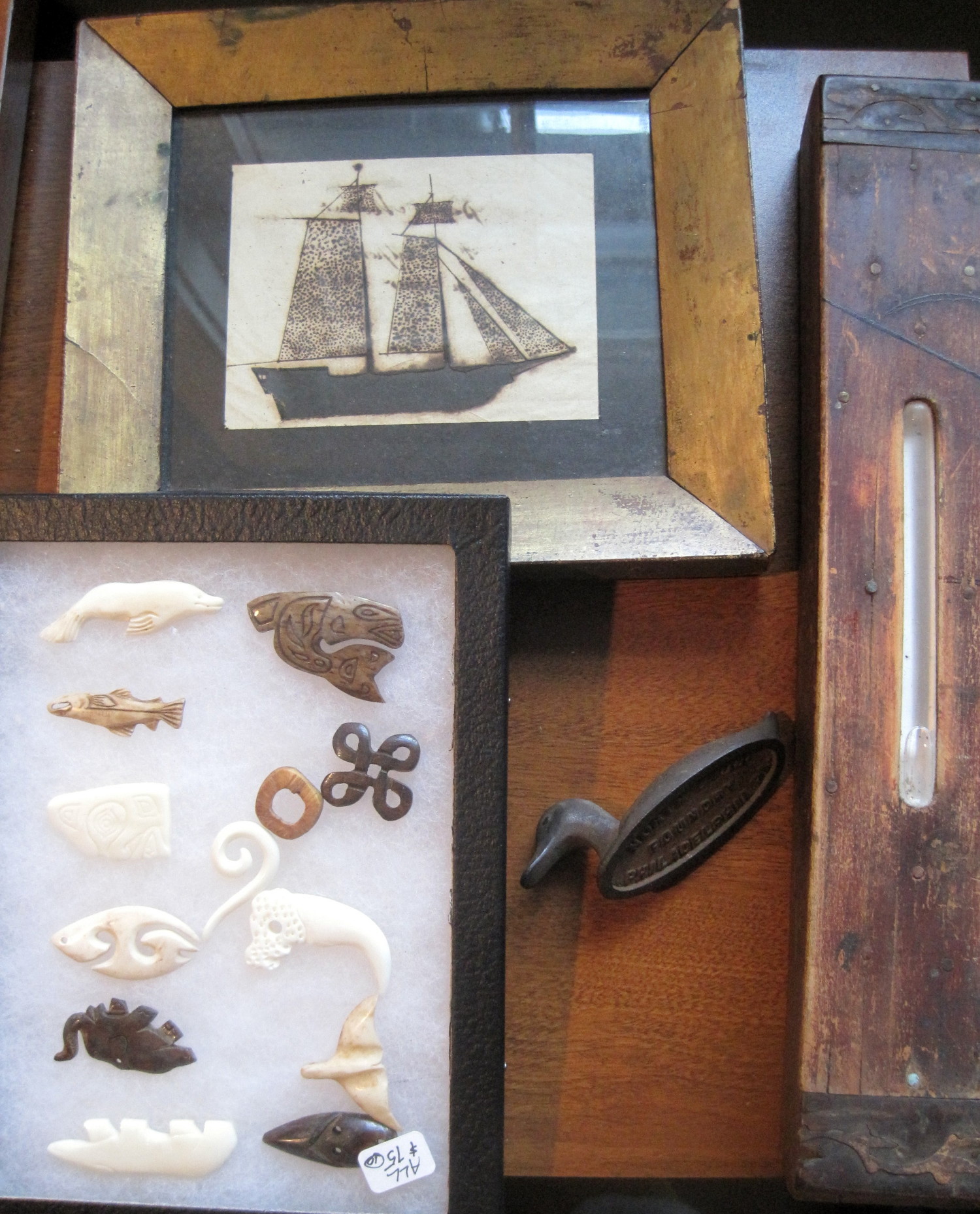
Tomorrow is another day!
Brimfield
Antiques Fair Report, May, 2014
Day 2 (Wednesday, May 14)
The hunt continued today, coursing
over the usual Wednesday route. This starts at 6am with the opening of the
New England Motel field ($5), proceeding to the Heart of the Mart field ($5) at
9am, followed by Jean Hertans field (no charge) at Noon. After the latter
field I generally am bushed by 1pm and on my way home. Today was no
different. The 8 hours spent walking on Tuesday certainly wears on this
old body, and 7 hours of the same on Wednesday taxes it pretty well. The
weather today was again beautiful, with lots of sunshine, little wind, and
pleasant temperatures. The buying crowd was large, and the dealer turnout
good. When New England Motel opened at 6am, I was near the head of the
line. Unlike other fields this one has recently had no dealer who
consistently sells good tools. So the technique is to quickly walk the
field, looking to both sides for the tell-tale image of a plane tote sticking
up, or some other indication of tools. My first stop, and the back of the
field, produced only a decently clean Amidon & White Co. ( Patent Amidon) sleeve
corner brace--not a common item--and little more. Things picked up a bit
at the stand of one of my favorite dealers and friend, Bill Joyce of Milo,
Maine. Bill, who carries a lot of eclectic stuff, had a pair of cast iron
rabbet planes with wooden wedges (one of them a compass rabbet) that were nice,
and a dandy larger Kimball draw knife in perfect condition. The prices
were high, but the deal was fair, and these joined the brace in my bag.
After this first quick survey of the
field, I pretty much retraced my earlier steps, but this time going into each
dealer's tent, and walking through it, asking the dealer for tools. Today
this technique was more productive than usual. In no particular order I
picked up a pair of crank neck gouges (one a dandy Charles Buck 2" shallow sweep
example), an 18th century 1/2" hollow plane that was not maker marked, but still
in nice condition; a rosewood mitre plane; and a Stanley No. 98 side rabbet.
In the tent of a lady who consistently has a pile of rulers --"I love them, but
don't know much about them," she says, and then puts high prices on them--I
selected three clean and handsome rules: Stanley 62 and 32, and a nice
Stephens No. 31 double bevel. Further down the row there sat in plain view
a very nice K7 Keen Kutter jointer plane. This was the model made by
Stanley, using the same ramp frog seating as the popular Bed Rock planes.
The price was right, and I thought it good fortune that it had lasted a couple
of hours before someone else came along. In another dealer's tent I found
what might pass for a table carving knife. But this one had added bone
handle grips, and was marked by the "Manhattan Cutlery Co." This was a
Sheffield cutlerer, using the Manhattan name for the American trade. The
bone sure looks like whale skeletal bone, and the grunge on the knife suggested
that it had been used on a whale ship as a "leaning" knife--that is one that was
used to trim bits of flesh from the blubber blankets before they were rendered
in the try works. At least, that is my story.
My final foray in this field was to
go through the enclosed sheds (there are three of them) where dealers can pay
premium rentals to set up out of the elements. Here the folks selling
expensive jewelry, art, ivory pieces, textiles, sewing implements, etc set up.
This is not a good place to find ordinary carpentry or machinist tools, but I've
had luck in the past looking for ivory rules and button calipers in these sheds.
Today was a lucky day. The first dealer's space that I examined had,
amidst the glitter of fine jewelry, an interesting ivory zig zag rule.
Swiss made, this one was graduated in centimeters on one side and inches in the
other. It had fine steel joint pins, with delicate ivory legs, measuring a
total length of 1 meter. Best of all, the price was right. Although
I didn't find another worthy piece in the other sheds, this made the tactic
worth while, and concluded a fairly productive visit to the New England Motel
field.
Now is was nearly 9am and time
for the Heart of the Mart field to open up. This is another field that is
problematical with respect to tools. There are usually only one or two
dealers who reliably sell tools, so it is pretty much catch as catch can.
Sure enough the pickings here today were fairly meager, with buys scattered all
over the field. They included a later Stanley No. 4 smooth plane in its
original box; a pristine American Brace Co. (Amidon) patent sleeve brace that
will go nicely with the corner brace found early at New England Motel; a group
of three fairly ordinary try squares, including a Disston try miter square, and
a Union 9" combo square, new, in its original box. The most oddball (for
me) purchase was a suitcase size Stanley motorized hinge and mullion set with
router and planer attachments. It is little used, and is a candidate for
someone's Stanley tool collection. This was a heavy beast, and I had to
borrow a cart to get it to the truck without another heart attack! So
endeth the Heart of the Mart field for May, 2014.
Jean Hertan's field opens at noon,
and while the dealers are (supposedly) prohibited from selling things before
noon, in fact there are often sales negotiated before hand. There is no
admission charge to the buyers, and they can circulate among the tents before
the bell rings at noon. My pre-noon scouting turned up very little in the
way of tools, but I did spot a quite nice bench-made whale boat model with plank
construction (not a kit), and was able to talk to the owner before hand.
At noon, the boat model was mine. After loading it into the truck, I
figured "what the heck. I've had enough shopping for the day, and drove
home. It was a decently productive Wednesday for me, leaving only Thursday
ahead. Picture below:
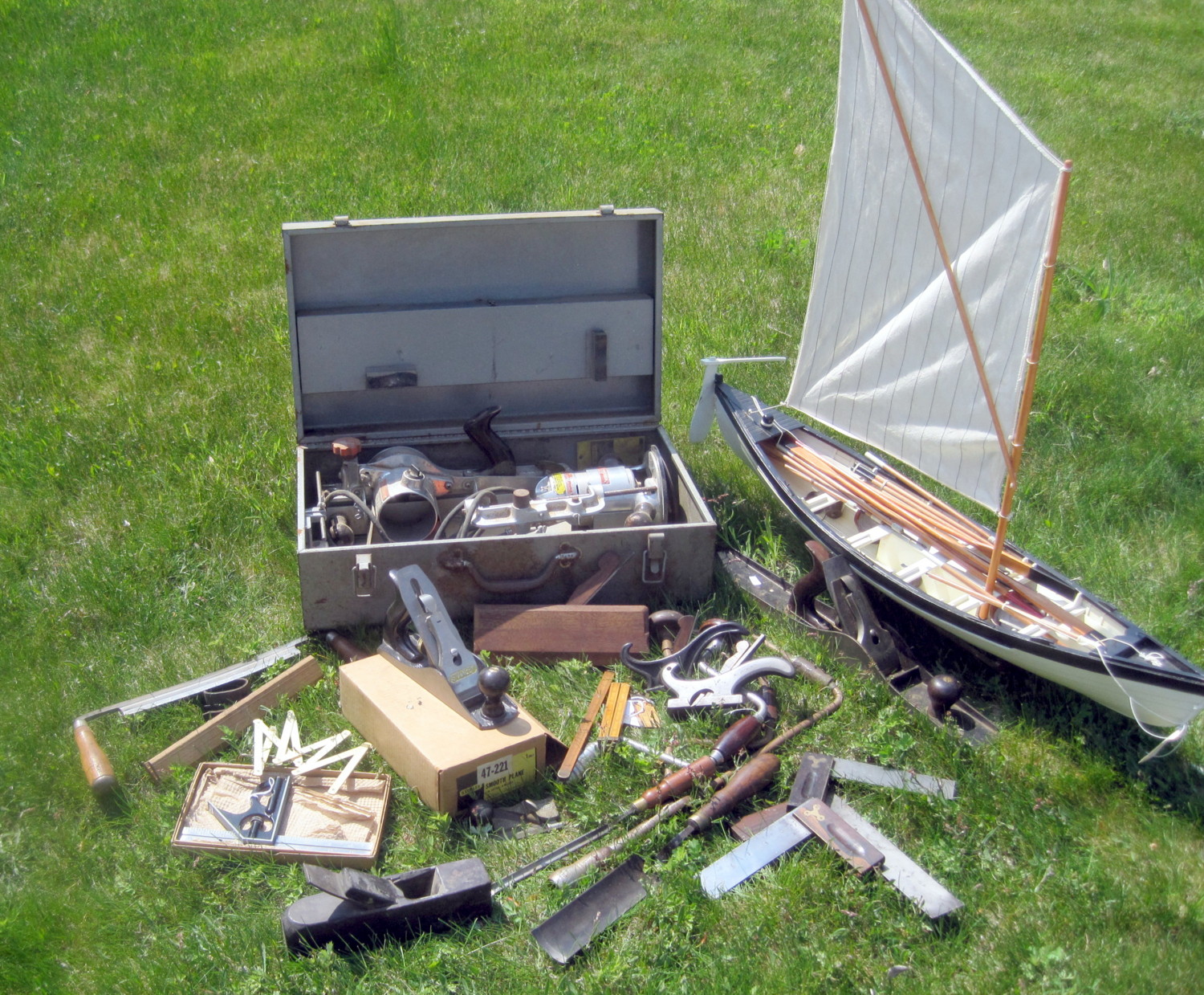
Tomorrow sees the opening of just one "new" field--Mays.
Brimfield Report, May, 2014.
Day 3 (Thursday) Mays
Today was an abbreviated one for me. My volunteer work at
the New Bedford Whaling Museum includes managing an annual "Nautical Antiques
Show" as a fundraiser each year. This is in conjunction with the
"Scrimshaw Weekend" that brings scrimshaw collectors to the Museum from all over
the country and beyond. My duties include preparing the exhibit hall for
the show, and greeting the dealers (this year there were 17) Thursday afternoon
and getting them settled in their assigned spaces. With time limited I
could only be at the Mays Brimfield show from 9am (when it opens) until 11 am.
This is barely time to get around the field once, but it is better than nothing.
Today the weather was again beautiful, and was made even more so by the company
of my wife, who enjoys shopping at Mays. Traffic was heavy, and we arrived
at the parking lot about ten minutes after the gates opened. This isn't
bad, since we didn't have to wait in line, and because at Mays the dealers are
not permitted to unload their wares until 9, things were just beginning to
appear as we went through the gate.
Mays is a big field, with up to 600 dealers (and it was pretty
full today), so it takes time to maneuver through the field. With Barbara
going her way, I went mine, looking for both tools and nautical antiques.
The first glimpse I got was a couple of rows into the field, where a set up
included a couple of whalebone canes, and some other nautical things. The
prices were on the steep side, so I passed on the canes. A nifty marking
gage did catch my eye, however, that featured mother of bone inlays around
fence of the gage. While waiting for the dealer's attention, I listened to
him deal with another customer--a husband & wife couple from Pennsylvania.
The spiel was an instructive one, and I learned something. The couple were
attracted to a small sewing stand with spool holders and decoration of whale
bone and ivory. To my eyes this was a newer creation, purporting to be
something that it wasn't--old. The asking price, $425, confirmed this (a
real 19th century whale man's sewing stand would be worth a grand or two).
But the dealer obviously wanted to sell the stand, and the prospective buyers
were hesitant--sensing perhaps that it might not be "right." So the dealer
dropped his price to $375. The buyers huddled, and finally agreed to buy
it, if they could pay for it with a personal check. The dealer recoiled
like he was shot, and then relented, saying, "Ok, I'll take the check;
just make it out for $400." It was now the buyers' turn to be shocked, and
they argued that the price of $375 had been agreed upon. So now the dealer
had craftily turned the concern of the buyers, from whether the piece was
worthy, to a matter of a mere $25. So when the dealer "relented," saying,
"Oh did I say that...well go ahead, write the check for $375," the buyers could
not get the check written fast enough. I thought this was a masterful
sales technique. The price by the way for the marking gage was completely
satisfactory to me. I didn't try to dicker.
In the next row of dealers, I found another guy with a good bit
of whaling stuff. His harpoons were sky high, but he had a nice New
Bedford made blubber spade that had an original marked handle. The
negotiation was fairly brief and satisfactory. So I bought the spade and
added an interesting serving mallet at a decent discount. He also showed
me an engraved tool and an engraved whale bone plaque that were surely over
priced. The next 30 or 40 minutes were spent just walking and looking,
with little production. I did pick up a pair of block planes in their
original boxes, and then a fairly uncommon H.D Smith "winged" handle screw
driver. This was from the last screwdriver patent of William Thomson, who
worked for H.D. Smith. These screw drivers were, I think, later made by
Sargent, and the Smith ones are not common. A small coil of 1/4" manila
rope caught my eye at another dealer's tent. This 50' coil had its
original label. Real manila line is hard to find these days. One other buy
from a general dealer was a nice Wilkinson folding handle draw knife.
An hour (of my precious two) had gone buy, and having checked
back with my wife, I headed for the front of the field. Very few tools
were in evidence to this point, but I did find a dealer who had just four tools
out, and these were pretty nice. One was a large roll of mixed carving
tools that was nice, but over priced. The other three were fairly priced,
and after quite a negotiation purchased all three. These included a decent
Sargent 714 "Buck Rogers" jack plane, an early form of the Davis "mantel clock"
inclinometer, and a showy Newark leather draw gage, by a little known maker, J.
Charlton. All of these spoke to me, and they went into the bag. In
the very next row, I found another general dealer, selling "Mid-Century Modern"
lighting (the "Buck Rogers" tools are also "Mid-Century Modern"--the current
rage--and should gain favor as decorating accents), but he also had a hefty
English brass frame shoulder plane stuffed with mahogany. With a 1 1/4"
blade this is a hefty tool, and I bought it.
With just a few minutes before my final hour in the field was
up, I finally made it to the front corner where the gun, scientific, and
scrimshaw dealers hang out. Among the science guys, I found my final buy
for the day, and the one that I liked the best. This was a cased heavy
brass standard yard rule--made for weights and measure inspectors to check
retail store scales and measures. This one was marked by the E. & T.
Fairbanks & Co. of St. Johnsbury, Vt, and in its original wooden case (somewhat
worn & beaten up) but with two locks. I've seen a couple of others of this
general form, but the distinction of this one is that it is a standard for
textile piece goods, being graduated in fractions of a yard as well as inches
for bolt widths. It is kind of a rare rule, I'm sure, and was very heavy
to lug back to the car. I have yet to find any record of linear measure
instruments made by Fairbanks.
It turned out that Barbara was very happy with her purchases of
some jewelry and Irish woolen sweaters, just as I was happy with a good (short)
week at Brimfield. Next July, we'll do it again.
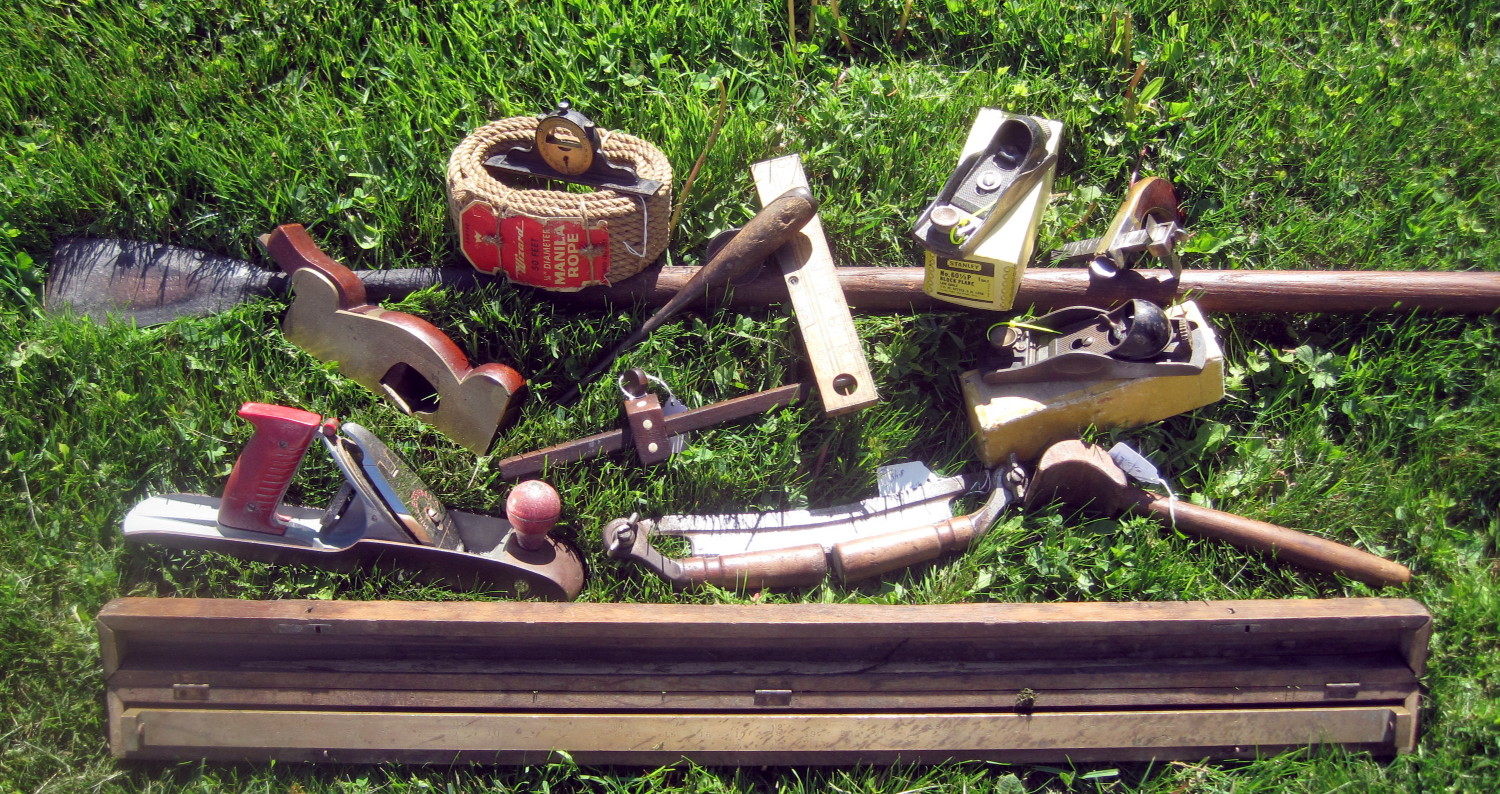
RETURN To Menu
Brimfield
Antiques Fair Report --July, 2013, Day 4
At Brimfield this July, my buying
report for the third day of the Fair (Thursday) is missing--simply because I did
not buy at May's field (the only one to open), but rather set up and sold there.
The weather was unsettled, with a heavy rain shower within the hour for the
field's opening at 9am. But the rain stopped just before the opening bell.
The dealer turnout was poor, and the crowd slim. But because I seemed to
be the only dealer on the field with quality tools and nautical antiques, I did
quite well. By the end of a long and tiring day, I was exhausted
physically, but happy emotionally.
Having left my tent and setup on the
May's field for the night, I returned the next morning at 7:30am, parking my
truck in my dealer's space and walking across the street to J&J's Field which
opened at 8:00. The intention was to shop for an hour or so, and then set
back up at May's for some more selling. And that is what transpired.
The shopping at J&J's for tools was poor, as it has been since this venue
changed its opening time from 6am until 8am a few years ago. This gives
dealers on the field--particularly one from northern New England to aggressively
"pick" the field of most decent tools, and then offer them at inflated prices
later on.
At any rate I walked the field
for and hour and a half, and came up with just a few tools. These included
a Wing Taber plow plane that is in marginal condition, but has the early "Fair
Haven" mark that was only used in 1833; a really nifty turn screw elaborately
shaped from a file, having curvaceous chamfered edges and a showy handle; a
small 6" Disston sliding T-bevel; and a nice but unmarked classic stair
saw. The best find of the morning was a group of 3 lignum vitae trucks
from sailing ships, including one of the quite uncommon ball variety.
These are hard items to find, and are decorative and easy to sell. The
dealer had no idea what they were, so they alone made the trip worth while.
Returning to May's field, I once
again spread out my wares under the first sun that we've seen for four days.
It again was a decent selling day, more than tripling what I sold on the second
day last year.
So home I returned, very tired and
weary of shopping without much results. But still it was a fun time, and
the folks I met and chatted with more than made up for the lack of tools found
during this week.
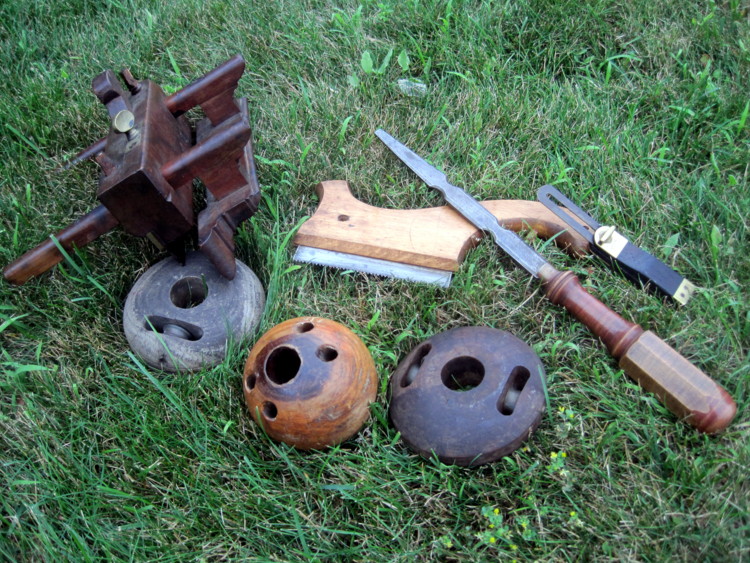
Brimfield
Antiques Fair Report --July, 2013, Day 2
The Wednesday meeting of the July,
2013 Brimfield Fair opened at 6:00am with the same weather conditions as on Day
1 (Tuesday), with humidity, fog, and drizzle. Like yesterday the weather
improved as the day wore on, with the sun actually breaking through the clouds
before noon. But the dealer turnout, and the few number of buyers really
decreased the normal excitement and results.
The opening field of the day was New
England Motel at 6am. This started off hopefully for me, with a quick buy
of decent examples of two saws--a Disston No. 12 and and No. 7l.
This was then followed by 2 hours of trudging the field with only a nondescript
thumb slide mortise gage to show for the efforts. The only positive was
the time to spend jawing with some dealer friends, telling little lies back and
forth. After depositing my saws in the truck, I recovered some of
yesterday's ground and managed to purchase some odd finds--a corn hook (of all
things) noteworthy for its complete paper label, and an interesting small bevel
edged tool that might be some sort of bark spud. After a break, the next
field to open was Heart of the Mart at 9:00 am. This also was a near
washout for me with only two purchases, one a set of quirky mahogany rules with
varnished paper scales--clearly a set of 11 architects scale--and 2, a very nice
ebony sail maker's seam rubber. This last was a nice find, but still it
was a short haul.
After some lunch and a little rest,
Jean Hertans' field opened at noon. I spent just about 45 minutes criss-crossing
the depauperate field, and came up with only an outsize carver's mallet that is
sort of nice, and then a dandy Jo, Fuller (Providence) yellow birch plane.
This was a nosing plane in the very narrow 3/8" width. I don't think that
I've seen a nosing plane this small. The plane is in fine condition, and
the dealer had it priced well below what I expected. He then quickly came
down to a price that truly made it a very good deal. Picture here.
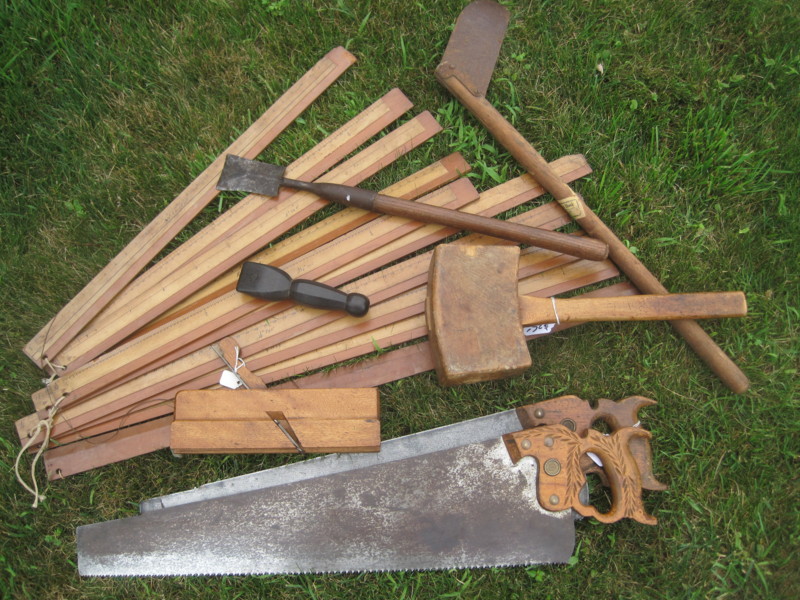
With this, my day at Brimfield was at
an end, so I came home in time to spend 3 hours packing my truck for tomorrow.
I'm going to set up at May's field tomorrow morning (dealer space 147 if any
galoots happen by) with lots of pretty good tools and nautical antiques to sell.
We're hoping for some better weather, but it sounds fairly dreary right now.
Sandy
Brimfield
Antiques Fair Report -- July, 2013, Day 1
Today the July edition of the 2013
Brimfield Antiques Fair opened to ominous weather forecasts of heat, humidity,
and a good possibility of afternoon thunder storms. Since Brimfield,
Massachusetts lies in the feared "thunderstorm alley" of the Worcester region,
and the entire state has suffered a spate of humid mid-nineties temperatures
lately, this forecast can only serve to dampen the enthusiasm of both dealers
and buyers. The well-deserved July weather excesses is so well known, that
this edition of the Brimfield Fair is historically the smallest of the three
held (May, July, and September) annually. So, when I cranked up the truck
at 3:15am this morning it was like getting ready to drive into a warm, wet sock
for the day. True, the day started off muggy, foggy, and drizzly; but by
late morning the humidity and temperatures had dropped, and so even with the
overcast it turned out to be a pleasant day for shopping. Fie on the
customers (and dealers) who chose to stay home.
My first stop, as always, was at the
Quakers Acres field, but this time I drew a near blank. My most reliable
dealer had nothing new, and wandering the field a little, I was on my way out,
when a newly opened (this is 5:30 am) had a large bucket of tools set outside
his tent. This included two unusual tools--cant dogs of an exceptionally
small size. Both were probably tools used by sawyers to adjust smaller
logs headed for the saws, and they were of a type I'd not seen before.
Along with these the Maine dealer also had a small shingling hatchet with a way
worn back (but very sharp) blade and an elongated claw on the other end.
The hatchet was marked, "Cast Steel" on one side, and "Jo??? Howe / Patent" on
the other. Well, It was an and engaging little hatchet, and I bought it
(along with the cant dogs). I can't remember having seen a patent shingling
hatchet before. Now at home, a quick visit to DATAMP confirms that this
hatchet is made according to Patent No. X8,291X issued to Joel Howe on
July 8, 1834, almost exactly 179 years ago. You learn something new every
day!
What followed these finds involved a
long walk east and an even longer walk west along U.S. Rte 20 with not much in
the way of results. My total take for the next four hours consisted of a
decent Spofford brace with 12" sweep, a cleaned type 11 Stanley 7C jointer
plane, 2 Buck Bros carving gouges with hexagonal handles, and a SW No. 5 Stanley
jack plane. Finally at the far western end of the Fair I located a decent
wooden plane. This is a small yellow birch coach maker's rabbet plane for
working curved rabbets. it is just 6 1/2 inches long, with flat chamfers,
and a skewed Moulson Bros blade. It is a sweet little plane, and the
seller threw in an eye-catching 7" beech compass plane. These planes ended
the first phase of today's search, so I took the long road back to the truck,
stopping at one of my favorite Maine dealers to get the lowdown on how the small
cant dogs were used. The small haul is shown here.
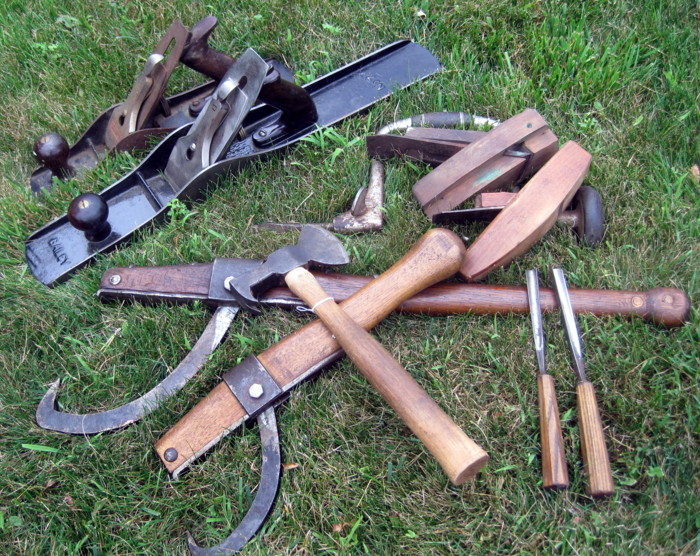
Today I chose to make a break from my usual pattern of
returning to the truck before the opening of the Meadows (11am) and Brimfield
North (1pm) field, and then making the trek back for the opening of those shows.
The deviance was that today I drove my truck to new parking place, much closer
to the soon to be opened fields, and thereby saved at least two miles of
walking. Hey, when you move into your middle 70s maybe a little pampering
is in order! At any rate it worked.
The Meadows field opened at 11am to a generally reduced field
of buyers, and an equally reduced field of dealers. As for tools I found
nothing worth buying at the prices being asked for the few tools there.
So, after 1 1/2 hours of walking, poking, conversing, etc. I managed to find one
item worthy enough to buy. The was the cochlear (internal ear) bone from a
large whale--probably a Sperm Whale. These are curiously shaped, and many
people would think them to be somewhat grotesque large cowrie shells. But
these are large, rugged, and heavy. The one I purchased is about 5 inches
long, 3 1/4 inches wide and 2 1/4 inches deep. It weighs a full pound.
These are often seen in scrimshaw collections, fancifully painted to emphasize
(in one view) a bulging forehead, sharp nose, and a jowelly jaw, giving the bone
the appearance of a fairly ugly gnome. Now I guess I'll have to invest in
some paints and brushes.
With this one purchase I crossed Rte 20 for the opening of
Brimfield North. When that happened I made a quick 45 minute walk through
the field, and purchased (in order): a very nice J. Kellogg moving fillester and
a S. Cumings nicely boxed bevel & ogee molding plane, a decent whale ivory pie
crimper (missing the fork), a rosewood S.S. Norton mortise gage, and a Tileston
Roman ogee with bead and bevel molding plane. This about cleaned the field
of the decent tools that I saw, so I took the short walk to the truck and came
home. When leaving it was apparent that the crowd was building, so perhaps
tomorrow at 6am Brimfield will become more alive. The picture is here.
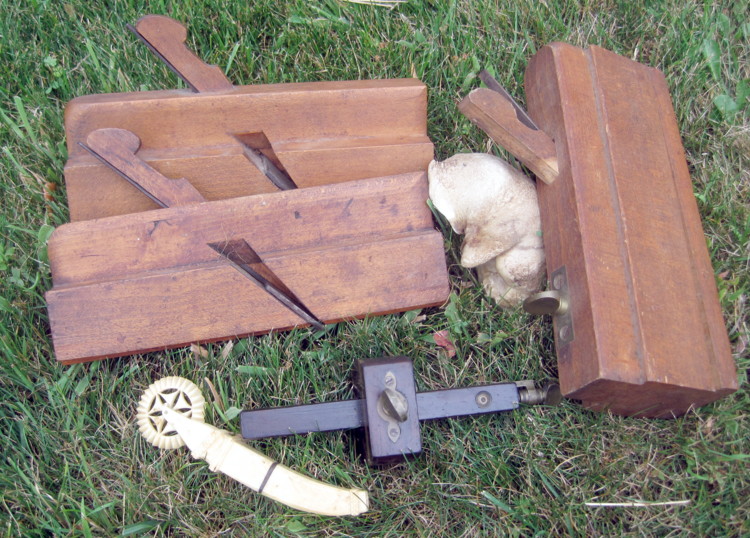
Brimfield Report Antiques Fair Report – May, 2013, Day 2.
Wednesday at Brimfield is a fairly fresh day. Three fields open for
the first time (although some savvy dealers switch their booths around).
The new fields are: New England Motel at 6am, Heart of the Mart at 9am, and Jean
Hertans at noon. The first two fields charge $5 admissions, and the
dealers have nearly unlimited time to set up their booths. The stinker
aspect of this is that dealers have time to pick the other dealers (before the
field opens), buying merchandise and planning to "flip" it for a higher price to
the customers. So, from a buyer's standpoint, naive dealers' mistakes are
corrected, and the chance of finding real "buys" diminishes as the average price
on goods offered for sale rises. The exception to this practice is the
Jean Hertans field. Here dealers can set their booths up, but are asked to
keep their goods covered until the opening bell, and are "prohibited" from
making sales prior to the noon start. In fact, this rule is routinely
violated, and many dealers will invite selected customers in to their booths to
make early purchases. This I know, since I've been an early buyer before,
and was again today. But this is just another part of the Brimfield
learning curve.
Today I arrived in the parking lot a little later than I like--due to a
considerable traffic jam coming into Brimfield--so I was in a long line when the
gates opened at New England Motel. The crowd was immense, in my
experience. But I saw few tool guys, so the known competition was reduced.
So, I just took my time, poking and prodding from one booth to another, trying
to cover the field (about 400 dealers here) methodically. The first find
was a surprise. It was in a booth with few tools, but a neat and intricate
shoe measure caught my eye. It was "different," having a mortised "lock"
in the closed position, but the measure unfolded with a nifty rule joint with
middle plates. The "toe" restraint could be flipped up only after sliding
the folding heel restraint back. The measure was graduated in shoe sizes
on the upper surface, but in inches on the reverse. The numerals were
ornate, and clearly 19th century. After seeing number of Belcher Bros and
Kerby shoe measures, this one was a delight. The price wasn't cheap, but
I'm happy with the buy. Besides the husband and wife dealers were delights
to chat with.
The next stop was a dealer that I've dealt with many times before. He
had a really interesting small mahogany chest with MOP escutcheons and lift top,
fitted drawers, and complete with labeled bottles and toiletry items. It
was clearly a travelling toiletry chest from the 1800s, and was just exquisite.
At an asking price of $300 I thought that this was a steal, and almost bought it
on spec. Reason prevailed, however, and I looked at his more mundane tool
offerings, coming away with a nice Stanley boxwood marking gage and a set of
somewhat dirty RJ auger bits. The next buy was an unusual screw arm
filletster plane literally covered with carvings and dates in the beech-like
wood. Clearly European in origin the dealer, in a thick Slavik accent pronounced
it to be "Hungarian." But the plane has a great look, so I bought it.
This was then followed by a nice buy of a small chisel, fitted with a whalebone
handle. I'm a sucker for this sort of tool, but the price was right,
and it will go on my nautical table. My good friend, Bill, from Maine then
showed me a really nice Drew & Co. wood handled fid (marlin spike, sail pricker,
whatever) that also went in the bag. Finally, closing out this field with
a tour through the three roofed sheds, full of bling (and sometimes ivory
rules), I found a nice lady from Greenwich, CT, selling nautical prints and
other things. She had a wonderful large print by one George F. Campbell
titled, "Ghostly Fore Top and Fore Yard." It is an extremely detailed
drawing of the transition in the rigging between the fore mast and top mast of a
sailing ship.I found it captivating, and we struck a mutually agreeable deal.
Cathy is the only antique dealer that I've met who also offers violin, viola,
and small string ensemble lessons.
By now, it was almost time to get in the line for the opening of the 9am field,
Heart of the Mart. A quick trip to the truck to unload, get a bottle of
water, then found me in a mass of humanity, waiting for the gates to open.
Time goes by quickly, however, when you can chat with others waiting in line,
and learning something of their interests and businesses. This time I
learned about jewelry and antique fabrics from a couple living in Rome, NY.
When the gates opened at noon, the rush carried me to my usual starting place,
which proved to be a bust--no tools. So again I started a slow and
methodical search of the field. I think it is important to look
really closely at all of the booths--not just the obvious tool havens.
Those are run by people who tend to know tools and their values; it's the
distaff oriented booths--maybe with a fairly sullen husband sitting in the back
surrounded by glass and glitter--that you will sometimes find the small
treasure, like a Davis level or an ivory rule. In this case the asking
price may be either cheap, or unrealistically high. Both of these
situations derive from ignorance. In the first case, make the buy--in the
second chat the dealer up and turn into teacher mode. Most of these
dealers like to learn about the things they've found, and appreciate the new
knowledge. Finish by making a realistic offer for the tool, not a low ball
one, but a genuine offer. It is sometimes amazing how the price can drop
to a third of their original asking price--or better. But my first stop in
Heart of the Mart wasn't with a naive dealer. This was a fellow whose
livelihood was as an auctioneer in central Maine. I've never met the man,
but we had several acquaintances in common, and so after some fun palaver his
price on a set of (again dirty) Greenlee bits, a nice Witherby draw knife, and a
Stanley SW Spofford brace came down to a very favorable number. After this
extended encounter quick fruition came from a dealer who had one of those lignum
carving mallets that are the rage, and from another non-tool dealer a partial
set of tools that I've not seen before. These are "reamers" marked with a
Millbury, MA and patent date. It was worth the miniscule price (then cut
in half) to do a little research on them. Next, the strategy of talking a
naive tool dealer down with some information got me a nice Disston tenon saw
with the contour handle for about a third of his asking price. Finally, I
visited to two dedicated tool dealers on the field. The first, from
Vermont, showed me a nice example of the smallest size of the uncommon Stephens
helical coil caliper, which I bought along with absolutely the nicest D.B.&S
triangular rule I've seen. It is mint! The final stop was at the
booth of a Connecticut guy, who finally stocked some braces. So I picked
up a very interesting Stanley 10" brace and one of the smallest Scottish pattern
braces that I've seen.
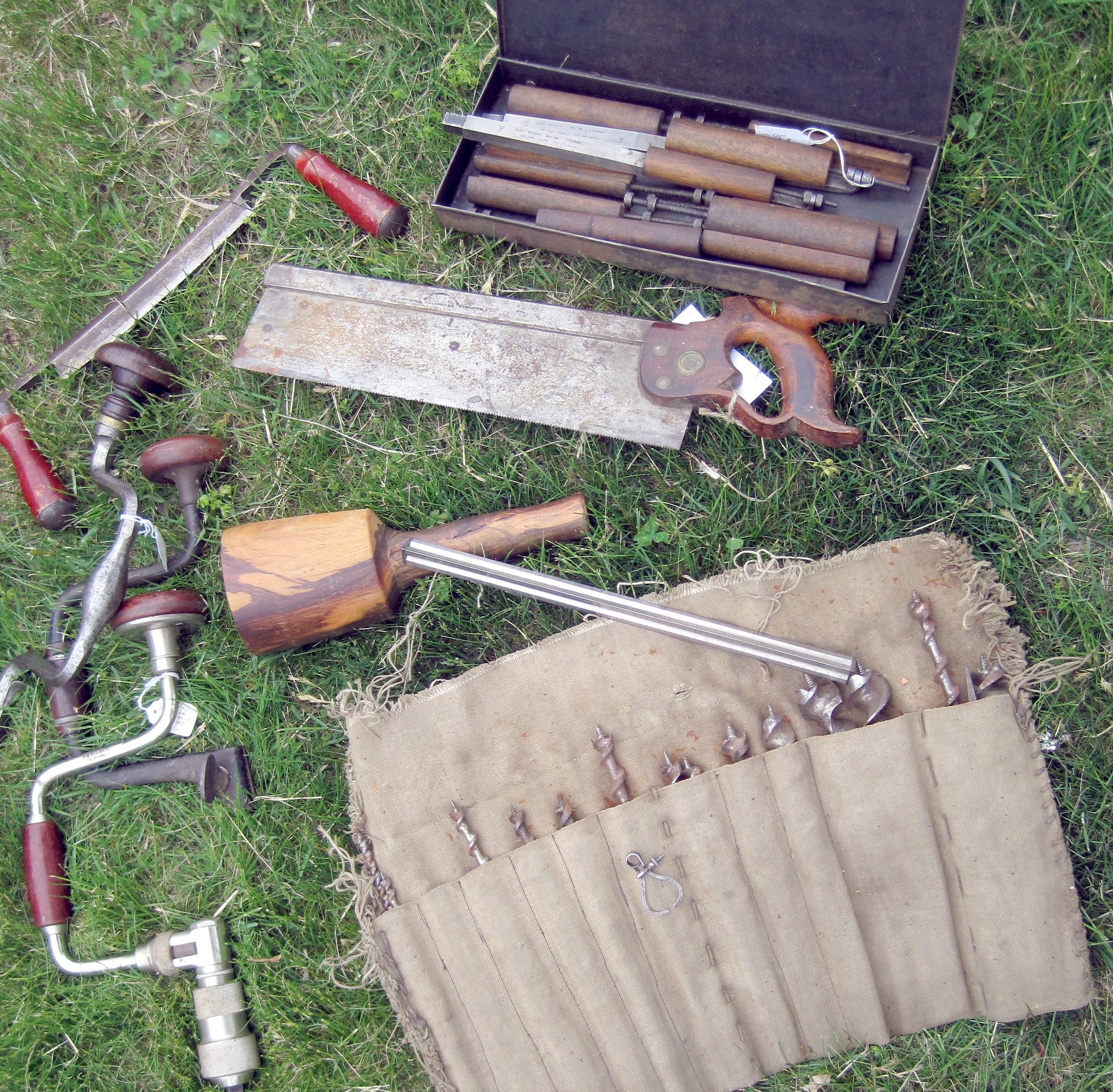
At this point it was time to carry the load back to the truck, have a bite
of lunch, and get ready for the Jean Hertans show to start. First I went
to a dealer who had mentioned that he had a couple of whale teeth. A bit
of a protracted negotiation resulted in two fairly large faux Sperm Whale teeth
in my backpack. In another pre-opening transaction I picked up a couple of
sets of stamps (numbers and letters), a nifty Maydole riveting hammer, and a
cute little compass saw. When the show finally opened at noon, I lucked
out on finding a quite decent baleen corset busk, nicely engraved by a whaleman.
It had the "good" insect damage that validates the material as baleen. The
price was very reasonable for this sort of thing. The final buy was from a
guy who had several planes on his table. One of these was the Stanley 104
steel bodied Liberty Bell Plane. This was the first type with patent date
and proper blade. It was accompanied by two No. 6 Stanley planes, all for
one very reasonable price. It was time to go home. All in all, I
felt this was a quite successful and enjoyable trip to Brimfield. I'll
definitely go back tomorrow for the opening of the Mays field.
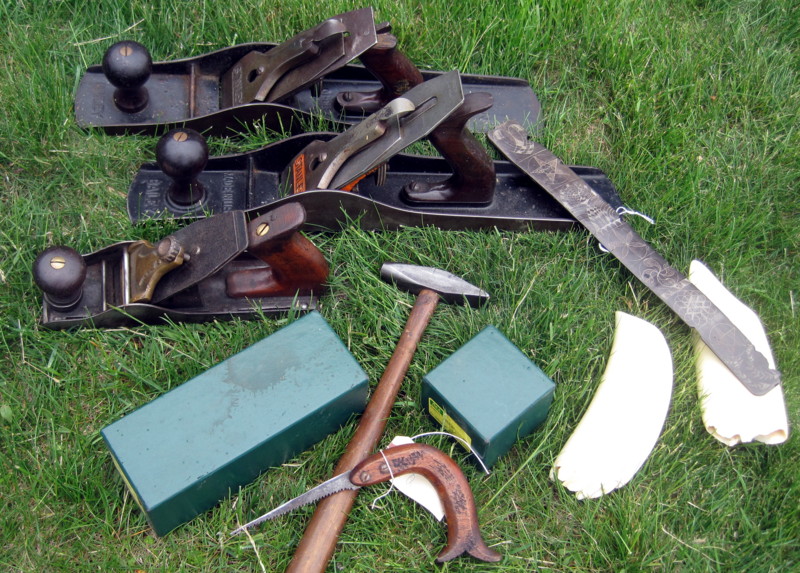
Sandy
Brimfield Report Antiques Fair Report – May, 2013, Day 1.
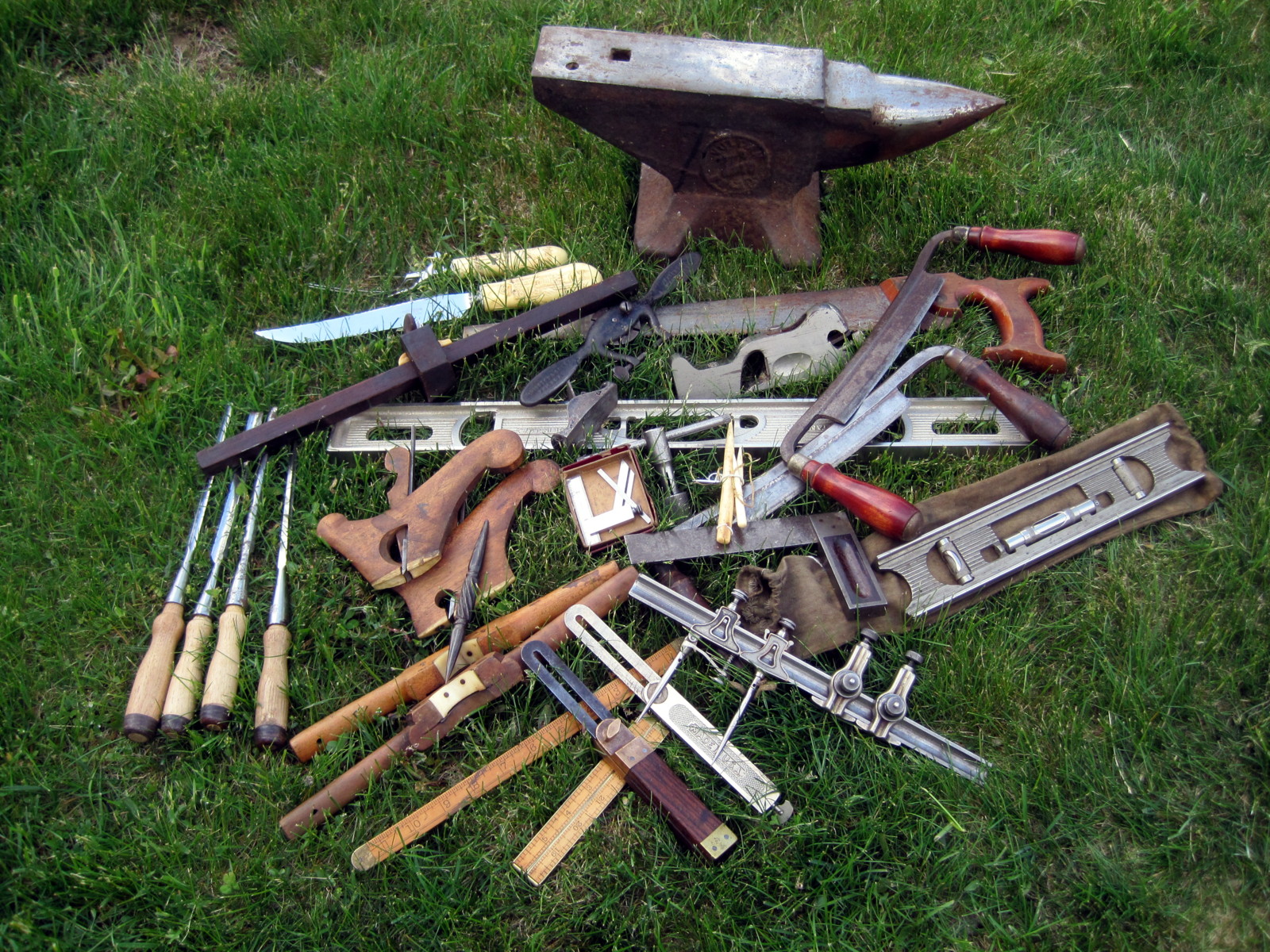
Back on track to what is, hopefully, an unfettered year of visiting the
Brimfield Antique Fairs, this morning's drive from Westport, MA to Brimfield, MA
was a relaxed affair. No traffic to speak of, and the 1.5 hour trip ended
as scheduled at 5am, parking in the May's parking lot. The parking fee
increased last year from $7 to $8, and that charge prevails this year. The
weather was cool (frost on the truck when I left home at 3:30 am), and a brisk
wind kept the jackets on most people--especially when the sun ducked behind the
clouds.
As usual, I started visiting my regular string of dealers, and was not
disappointed. Gary had some good machinist tools, and some other things
that seemed worthy. The bag at this first stop included a pair of Starrett
trammel sets (Nos 50 and 59); a Starrett No. 14 Double Steel Square, with all
three blades; Brown & Sharpe diminutive No. 498 bevel square (head & tongue only
1 1/4"); a somewhat worn but solid Howard Patent bevel square made by the Star
Tool Co; a clean and shiny Stanley No. 18 bevel square; and uncommon but nice
example of Disston's revolving saw. Finally I picked out two clean
rules--a Lufkin No. 42 shipwright's bevel and a shiny Stanley No. 62 four fold
rule. Before leaving the field I found a good solid Pexto 8" draw knife
and a hefty Millers Falls tap wrench with four-jaw chuck.
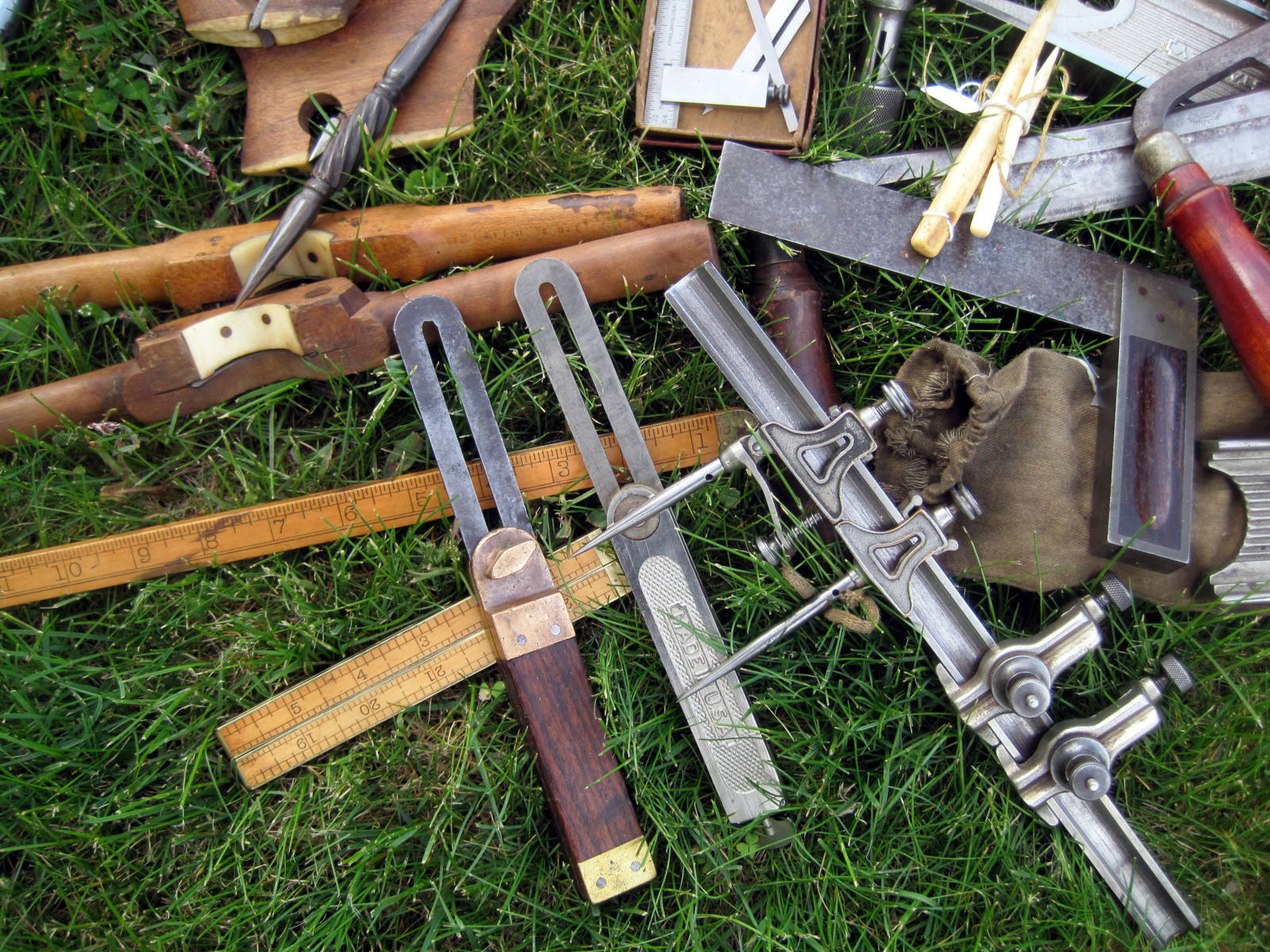
With these tools in the bag, I moved south along rte 20, seeing a plethora
of tool guys--the competition was keen today. En route I found another
PS&W draw knife, and then a pretty nice Vulcan anvil showed up. This one
weighs in at just 65 lbs. This is a nice size and is small enough to keep
SWMBO from yelling at me about hernia risk. The dealer is one that I buy
things from regularly at our local Sunday Flea market, so there was no problem
stashing the anvil with him, to be recovered on my way home.
Dropping the tools gleaned thus far at the truck, I then ventured to the
north, finding fairly little, but enjoying chatting with some of the dealers
I've done business with over the years. Finally, in a pretty junky booth a
bright shiny nickeled Stanley No. 37 24" level hove into view. This was an
interesting one, for it apparently had never been finished. Although the
screw holes had been tapped to receive the two plumb and one level vial, there's
no indication that they were ever attached. The top rail of the level is
marked with scribbling that reads, "Milled too Deep." In fact when you
look at the grooving on the bottom rail for its use as a shafting level, the
groove is appreciably deeper than ordinarily seen on No. 37 (or 36) levels. So
this appears to be a factory reject unfinished level--certainly a nice piece for
a level collection. The same dealer had a great example of another No. 36
level, this one a 12 size with B casting marks and all the other attributes of a
type 1 No. 37. It had been kept in a heavy canvas bag for most of its 110
years and is primo condition. You can bet both of these levels went into
my bag. This trip north produced only two other tools, a George Bishop
table or carcase saw that was clean and shiny, with a good etch, and a somewhat
worn Stanley plated tri square--So I headed back south to unload again, get a
bite to eat, and fix a pickup time for the anvil.
En route I managed to add a few things to my purchases. The first of
these a nice small set of Union Hardware Co. straight gouges in just about new
condition. The second purchase included a pair nicely made coach maker's
rabbet planes, both with appropriately ornate bodies, and both fitted with bone
wear strips to the sole. The make a showy pair of planes. Along with
them came a pair of concave sole scrapers, also fitted with wear plates to the
curved soles. There are two degrees of sweep to these, and the ivory
plates look like they could have been cobbled from a whale tooth having the
proper curvature. At any rate they will make nice item on my nautical
table at shows.
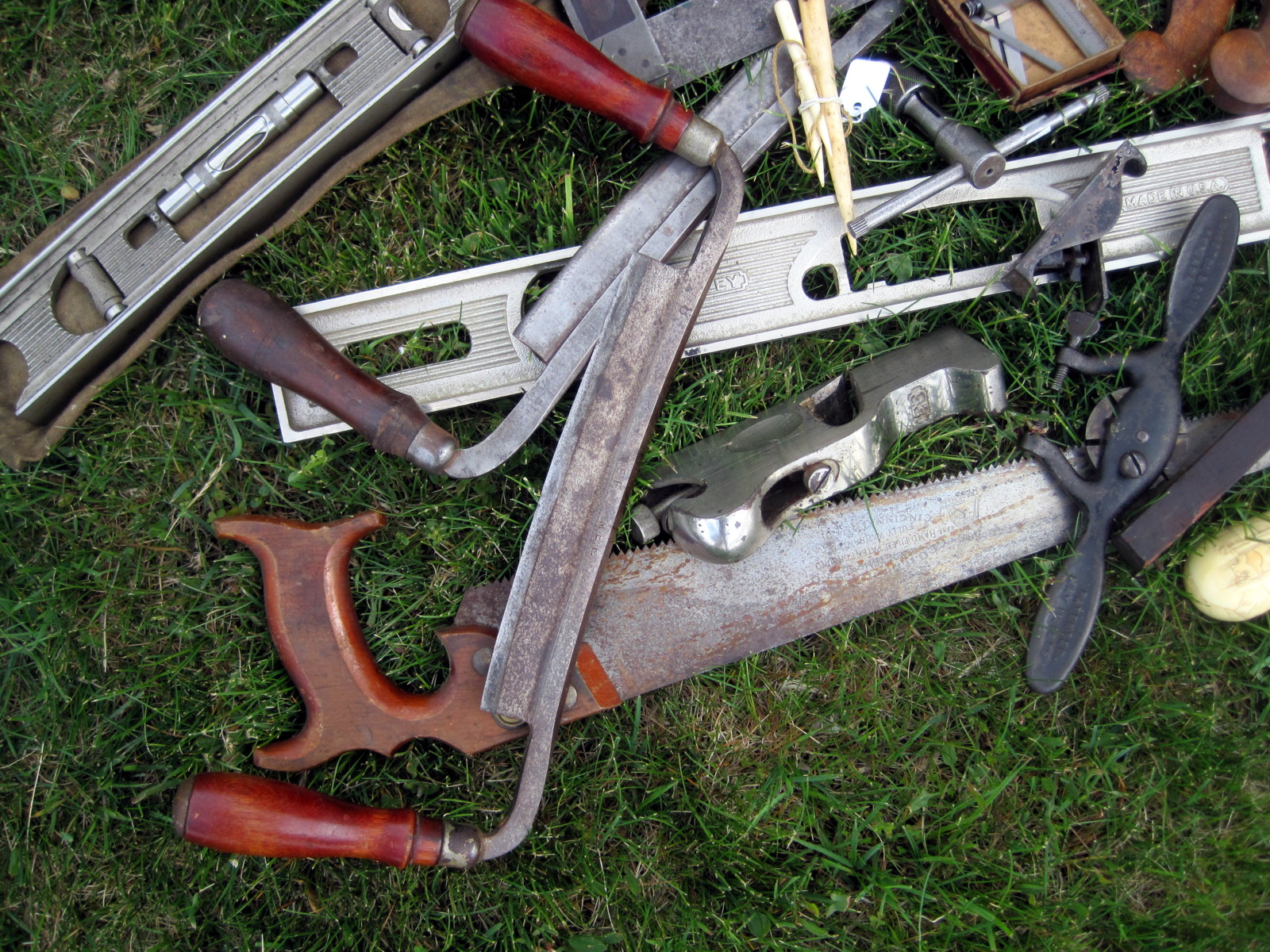
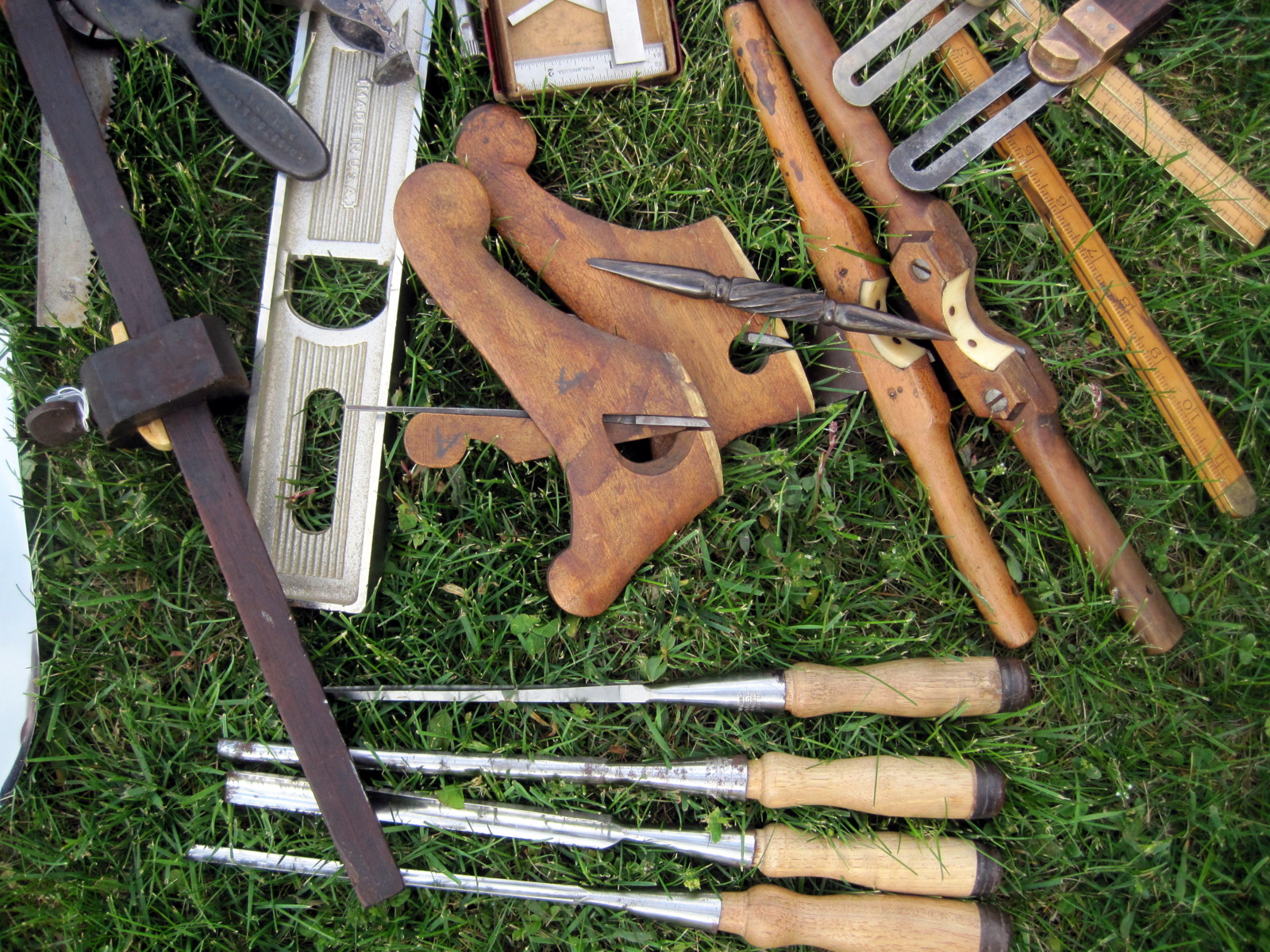
With this purchase, I again trekked back to the truck, and then north again
to the far end of the Brimfield venue. Here the Dealer's Choice field
opens at 11am, and the the Brimfield North field opens across the street at 1pm.
Dealer's Choice is sometimes barren of tools, and that certainly was the case
today. My purchases were all in the category of scrimshaw. The first
was an interesting piece of whale baleen just a few inches long, and pointed at
each end. One end has a flattened point, and the other a sharp symmetrical
point. The interesting part was the midsection that had been artfully
carved into a series of slanted ribbons encircling the tool. I don't have
any idea of what it might have been used for. Guesses include use as a
fid, with both ends; and a the far out one of a hair pin for a woman. This
will take some study. I also found a small whale bone fid with a lanyard
hole, that was probably a sail maker's fid. This came with a couple of
bone bodkins, of no real distinction except that they were inexpensive.
The final find of this field was a knife and fork carving set with handles made
of ivory that had been scrimmed and carved in an intricate fashion to produce
views of Northwest coast totem pole and other Alaskan scenes (dogsleds, sailing
ships, mountains, ice, etc. The scrimshaw is polychromed, and really quite
nice. Surely not old, they caught my interest, especially since they were
clearly carved from Walrus tusk ivory. After looking them over, I was
returning them to the dealer while asking for a price. I was astounded
when he said he didn't know what they were made of, and was asking only a tenth
of what I had expected. So they went into the bag as well!
After resting my sore feet for half an hour, the final field of the day
opened. This is a large field, well populated with dealers. Usually
you can find some tools, but they are often over cleaned, and over priced.
But when the gates opened, I headed directly for the booth of one dealer from
whom I've bought a lot of tools in the past. Today didn't disappoint,
although the pickings were more slim than I would have liked. When the
dust cleared, I had a small pile of three objects. A mahogany panel gage
with a whale ivory wedge, a quite decent Stanley No. 93 Cabinet Maker's Rabbet
Plane, and (best of all) and a proper example of Bailey's No. 51 "Little Victor"
block plane.
So, all in all, it was a fun day. The pile of tools is not large, but
I'm happy with just about all of my purchases. And the hunt goes on again
tomorrow with the opening of New England Motel at 6 am.
Sandy
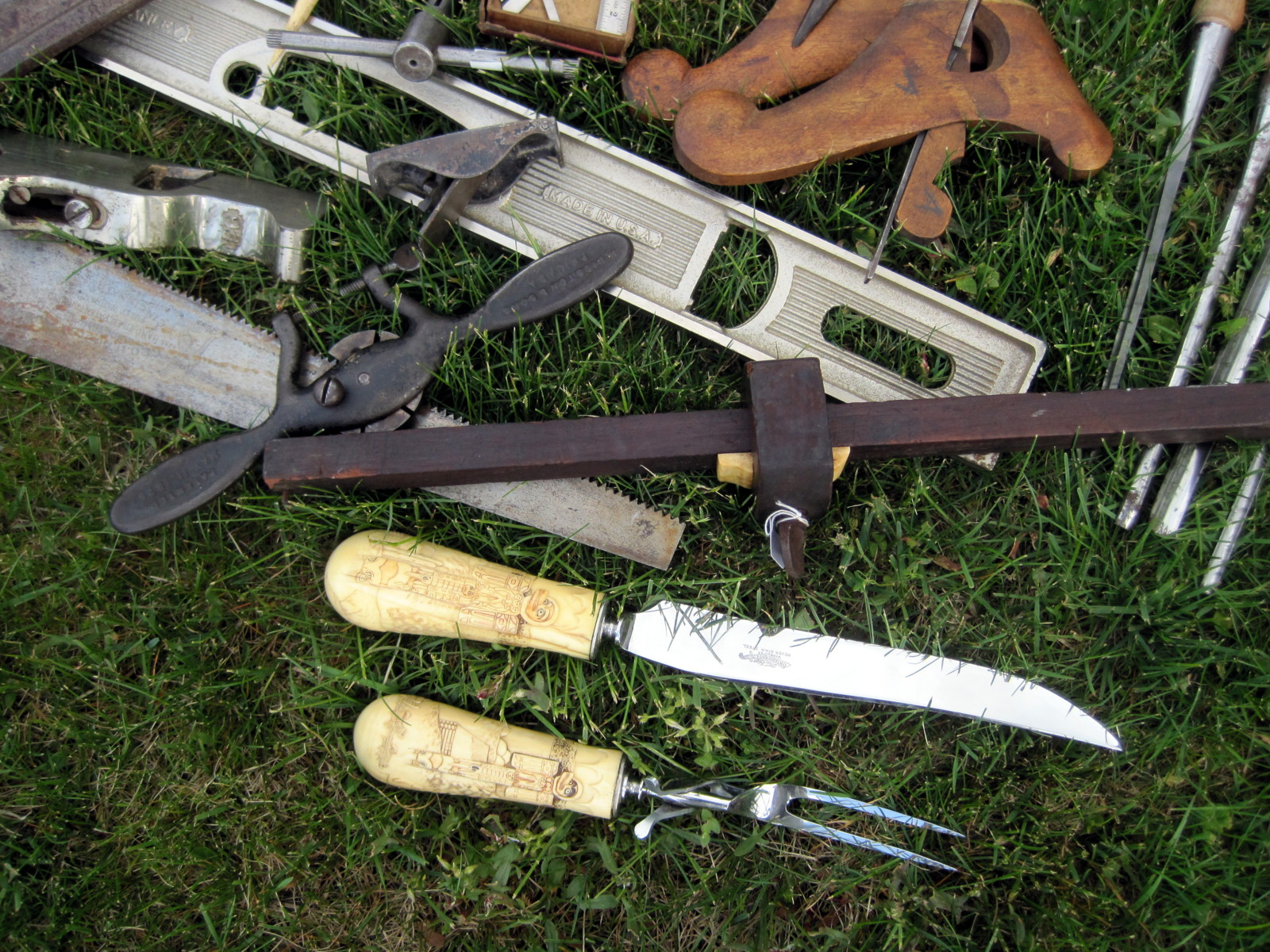
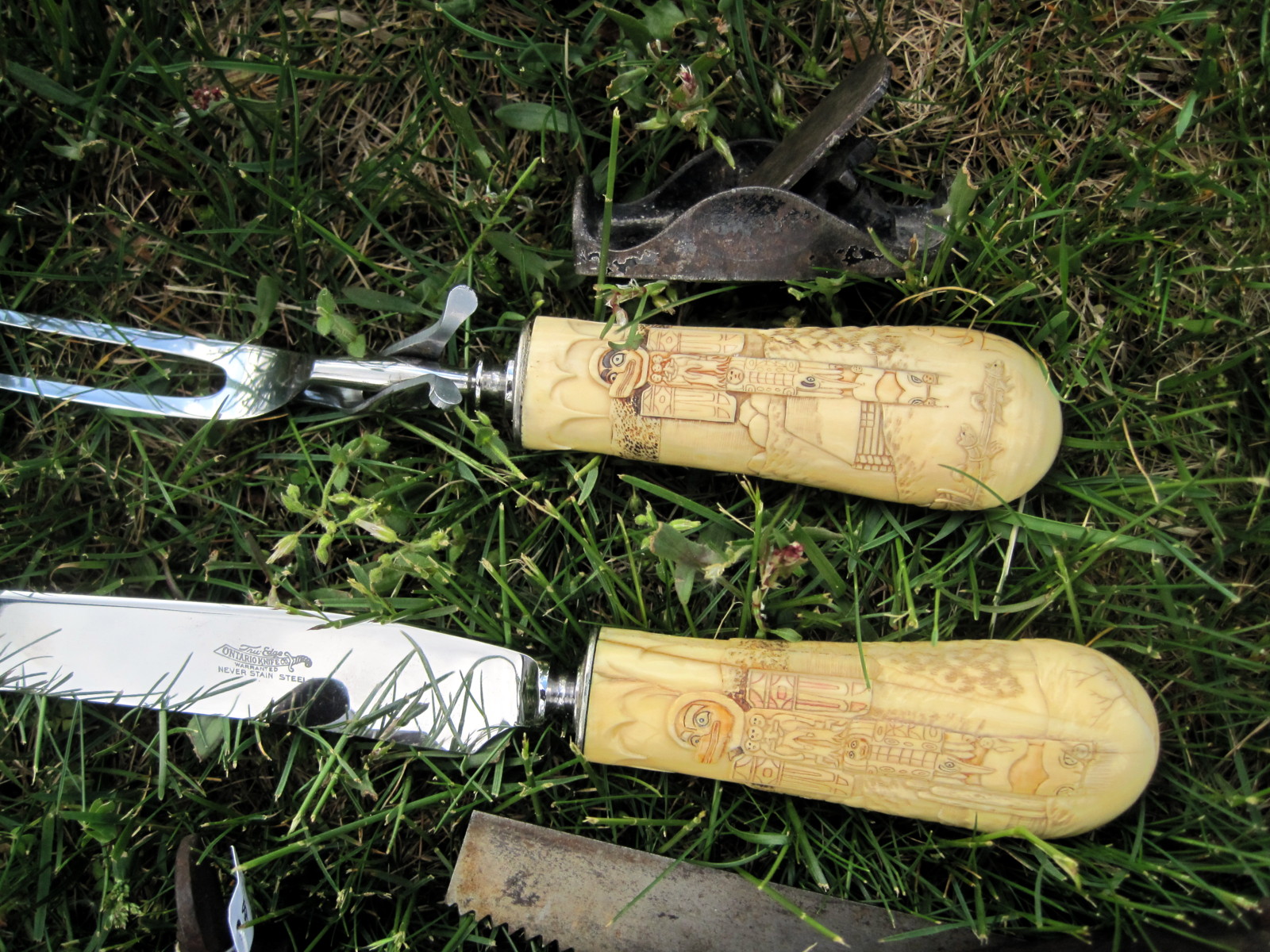
RETURN To Menu